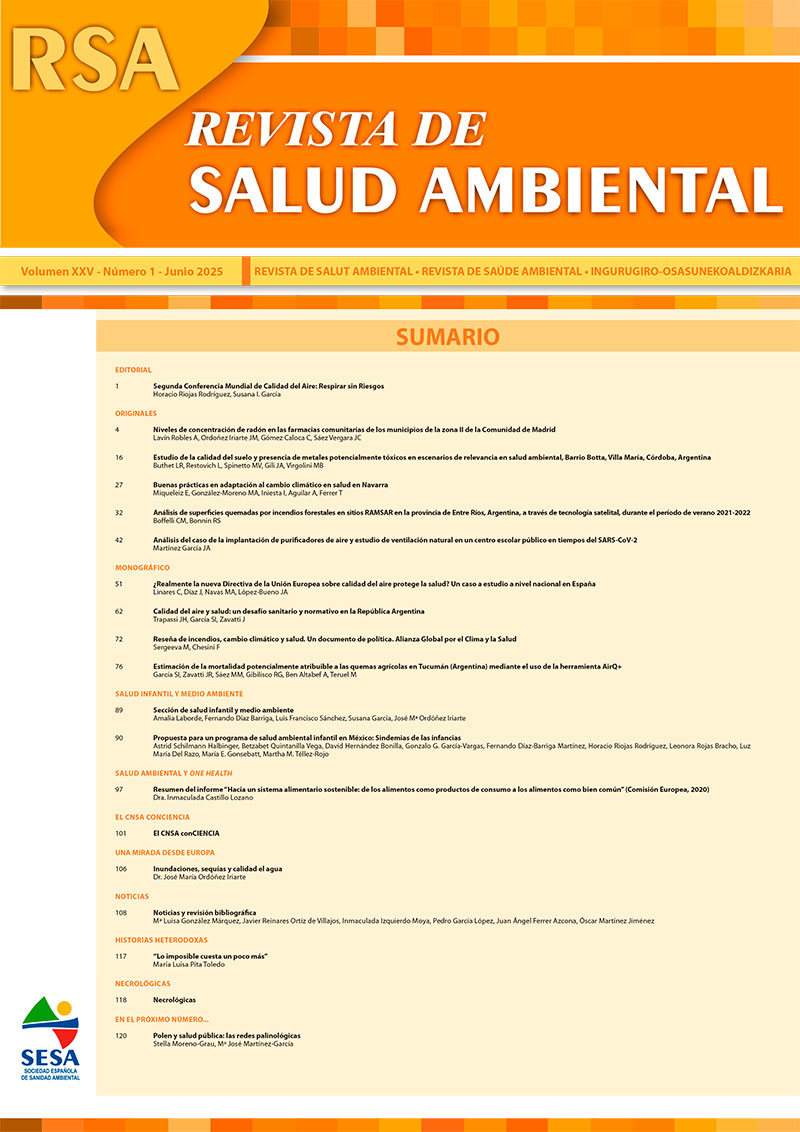Abstract
Forest fires impact biological diversity through a decrease in biomass and modification of the behavior of animal and plant species. Likewise, smoke significantly reduces photosynthetic activity, affecting human and animal health.
The research approach is quantitative in nature with descriptive scope. To meet the proposed objectives, the new Geographic Information Technologies (TIGs) were used: remote sensing, geographic information systems (GIS) and spatial and thematic databases available on the WEB.
The objective of this research work is to identify and characterize the areas affected by forest fires and analyze their subsequent evolution, through satellite technology, during the 2021-2022 summer season in RAMSAR sites in the province of Entre Ríos, Argentina.
In the first instance, an environmental characterization of the study area was carried out using web databases. Heat sources were then identified from the National Aeronautics and Space Administration (NASA) world fire map.
Subsequently, satellite images from different dates of the study period were downloaded and processed and different indices were used such as the Normalized Index of Burned Areas (NBR) and the determination of the degree of severity of forest fires.
The results of this study can be used to compare with upcoming forest fire seasons and analyze the progress of this phenomenon on our surface and what measures can be taken for its control and possible early warning systems.
References
Asociación Geoinnova. El cambio climático contribuye a los incendios forestales. [actualizado en 2020; citado el 15 de octubre de 2022]. Disponible en: https://acortar.link/det3TK.
Nasi R, Dennis R, Meijaard E, et al. Los incendios forestales y la diversidad biológica. Rev. Unasylva. 2002; 53 (209).
Aguilar Arias H, Mora Zamora R, Vargas Bolaños C. Metodología para la corrección atmosférica de imágenes Aster, Rapideye, Spot 2 y Landsat 8 con el módulo flash del software ENVI. Rev. Geográfica de América Central. 2014; 2(53):39-59.
Chuvieco E. Fundamentos de Teledetección Espacial. 3ra ed. Revisada. Madrid: Ediciones RIALP S.A.1996.
Chuvieco E. Fundamento de Teledetección Espacial. 2da ed. Madrid: Ediciones RIALP S.A. 1995.
Vales J, Pino I, Granado L, et al. Cartografía de la afección y recuperación vegetal del incendio de Las Peñuelas en Moguer (Huelva) con imágenes satelitales, año 2017. Rev. de teledetección. 2020; (57):79-94.
Montorio Llovería R, Perez Cabello F, García Martín A, et al. La severidad del fuego: Revisión de conceptos, métodos y efectos ambientales. En: Arnáez Vadillo J, director, et al. Geoecología, cambio ambiental y paisaje homenaje al profesor José María García Ruiz. España: Consejo Superior de Investigaciones Científicas, CSIC, Instituto Pirenaico de Ecología : Universidad de La Rioja. 2014. pp.427-40.
Nieto Marsot A, Garcia Paredes C, Fernandez Sanchez A. Estudio de casos para detección y análisis de fenómenos naturales con imágenes de SEVIRI, MODIS y LANDSAT 5: emisiones volcánicas, ciclogénesis explosivas y grandes incendios forestales. Rev. GeoFocus (artículos). 2011; (11):375-408.
Michalijos M, Uboldi J. Propuesta metodológica para la evaluación de áreas afectadas por incendios mediante el uso de imágenes satelitales (Sierra de la Ventana, Argentina). Rev. Geografía Norte Grande. 2013; (56):223-34.
González A. Identificación de áreas quemadas por medio de índices espectrales utilizando imágenes Sentinel-2 en el municipio de Orocué, Casanare [Aspirante a especialista en geomática, Universidad Militar Nueva Granada]. 2020. Disponible en: https://acortar.link/qDJqyw.
Mena Lopez S. Identificación de áreas afectadas por incendios forestales utilizando imágenes satelitales Landsat 8. Rev. Geográfica del Sur. 2017; 8(12):15-25.
Verdú, F., Saldivia, S. Variación espacial de índices espectrales sobre áreas quemadas en Sudamérica. Cuadernos de investigación geográfica. 2007; (33):39-58.

This work is licensed under a Creative Commons Attribution-NonCommercial 4.0 International License.
Copyright (c) 2025 Spanish Journal of Environmental Health

